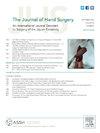Phocomelia Re-Examined Using the CoULD Registry
IF 2.1
2区 医学
Q2 ORTHOPEDICS
引用次数: 0
Abstract
Purpose
Phocomelia is an intercalary segmental dysplasia of the upper limb, a distinct entity from longitudinal deficiencies. Nearly 20 years ago, more severely dysplastic limbs initially thought to be phocomelia were able to be reclassified as more severe forms of longitudinal dysplasia. This study sought to evaluate current phocomelia cases to identify if these represented true phocomelia.
Methods
Using the Congenital Upper Limb Differences Registry, all cases of phocomelia were evaluated to consider the phocomelia diagnosis. Twenty patients were included for assessment, in whom 23 extremities were classified as phocomelia. Three extremities had clavicle dysplasia and were not included in the final assessment. The radiographs, clinical images, and medical histories were examined to assess the limb diagnosis. Patients with Type V ulnar or radial longitudinal dysplasia were also evaluated to ensure no possible mis-classification.
Results
All extremities could be reclassified as either ulnar longitudinal dysplasia (ULD) or radial longitudinal dysplasia (RLD), with 18 ULD and 5 RLD. No true case of phocomelia was identified in this cohort. Extremities with more severe dysplasia than type V classifications were able to be classified using associated syndromes, contralateral limb diagnosis, lower limb involvement, bony morphology, and hand/digit patterning.
Conclusions
True phocomelia is rare and most severely dysplastic limbs can be classified as ULD or RLD with specific guidelines, which is critical in clinical care, in assessing for additional medical comorbidities, and for family counseling.
Clinical relevance
Patients with presumed diagnosis of phocomelia should be critically reassessed, using other patient characteristics (syndrome diagnosis, lower limb involvement, etc.), for RLD or ULD to ensure necessary medical testing is completed.
使用can注册表重新检查Phocomelia。
目的:足部畸形是上肢骨间节段性发育不良,与纵向缺陷不同。近20年前,更严重的肢体发育不良最初被认为是光秃,后来被重新归类为更严重的纵向发育不良。本研究旨在评估当前的光秃病例,以确定这些是否代表真正的光秃。方法:采用先天性上肢差异登记表对所有光秃病例进行评估,考虑光秃的诊断。20例患者被纳入评估,其中23例四肢被归类为光秃。其中3条肢体有锁骨发育不良,未纳入最终评估。检查x线片、临床影像和病史以评估肢体诊断。对V型尺侧或桡侧纵向发育不良的患者也进行评估,以确保没有可能的错误分类。结果:所有肢体均可重新分类为尺侧纵向发育不良(ULD)或桡侧纵向发育不良(RLD),其中ULD 18例,RLD 5例。在这个队列中没有发现真正的光秃秃病例。与V型分类相比,严重发育不良的肢体可以通过相关综合征、对侧肢体诊断、下肢受累、骨形态和手/手指模式进行分类。结论:真正的光秃是罕见的,大多数严重发育不良的肢体可以被分类为ULD或RLD,并有特定的指导方针,这在临床护理、评估其他医疗合并症和家庭咨询中至关重要。临床相关性:应根据其他患者特征(综合征诊断、下肢受累等)对疑似光秃的患者进行严格的重新评估,以确定是否存在RLD或ULD,确保完成必要的医学检测。
本文章由计算机程序翻译,如有差异,请以英文原文为准。
求助全文
约1分钟内获得全文
求助全文
来源期刊
CiteScore
3.20
自引率
10.50%
发文量
402
审稿时长
12 weeks
期刊介绍:
The Journal of Hand Surgery publishes original, peer-reviewed articles related to the pathophysiology, diagnosis, and treatment of diseases and conditions of the upper extremity; these include both clinical and basic science studies, along with case reports. Special features include Review Articles (including Current Concepts and The Hand Surgery Landscape), Reviews of Books and Media, and Letters to the Editor.

 求助内容:
求助内容: 应助结果提醒方式:
应助结果提醒方式:


